Abstract
Positron emission tomography of cerebral glucose metabolism in adult human subjects was used to investigate amygdaloid complex (AC) activity associated with the storage of long-term memory for emotionally arousing events. Subjects viewed two videos (one in each of two separate positron emission tomography sessions, separated by 3-7 days) consisting either of 12 emotionally arousing film clips ("E" film session) or of 12 relatively emotionally neutral film clips ("N" film session), and rated their emotional reaction to each film clip immediately after viewing it. Three weeks after the second session, memory for the videos was assessed in a free recall test. As expected, the subjects' average emotional reaction to the E films was higher than that for the N films. In addition, the subjects recalled significantly more E films than N films. Glucose metabolic rate of the right AC while viewing the E films was highly correlated with the number of E films recalled. AC activity was not significantly correlated with the number of N films recalled. The findings support the view derived from both animal and human investigations that the AC is selectively involved with the formation of enhanced long-term memory associated with emotionally arousing events.
Full text
PDF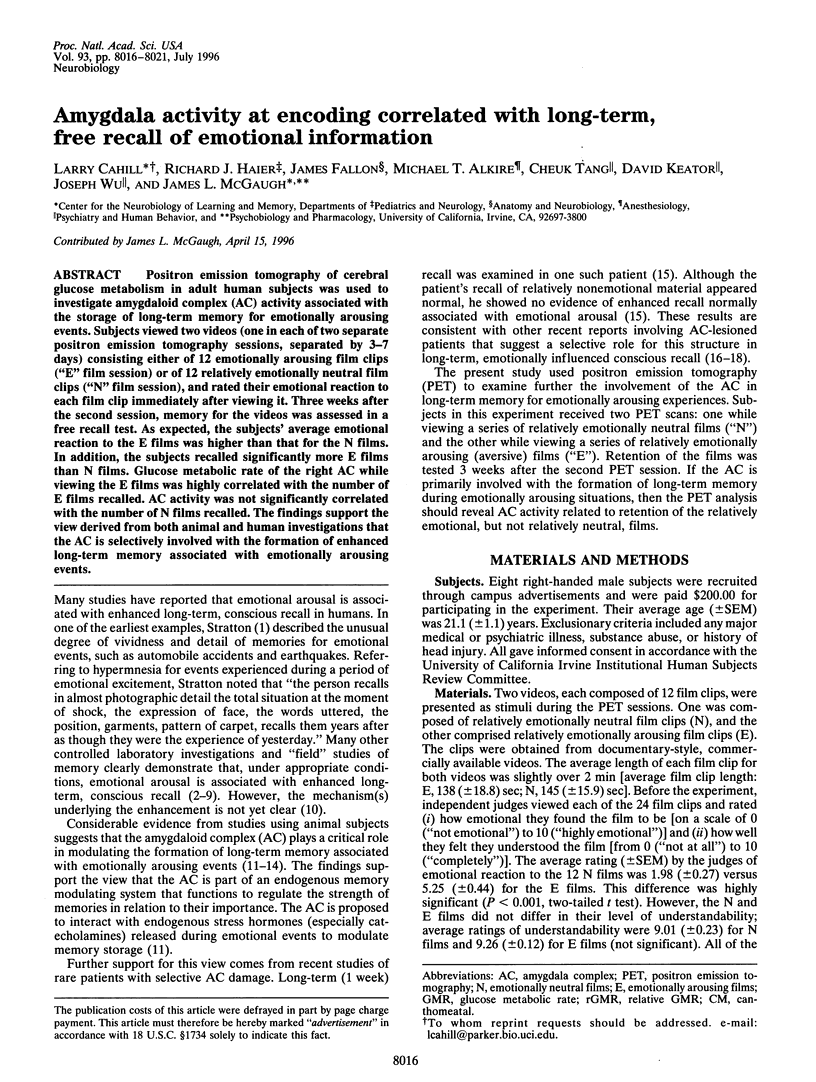
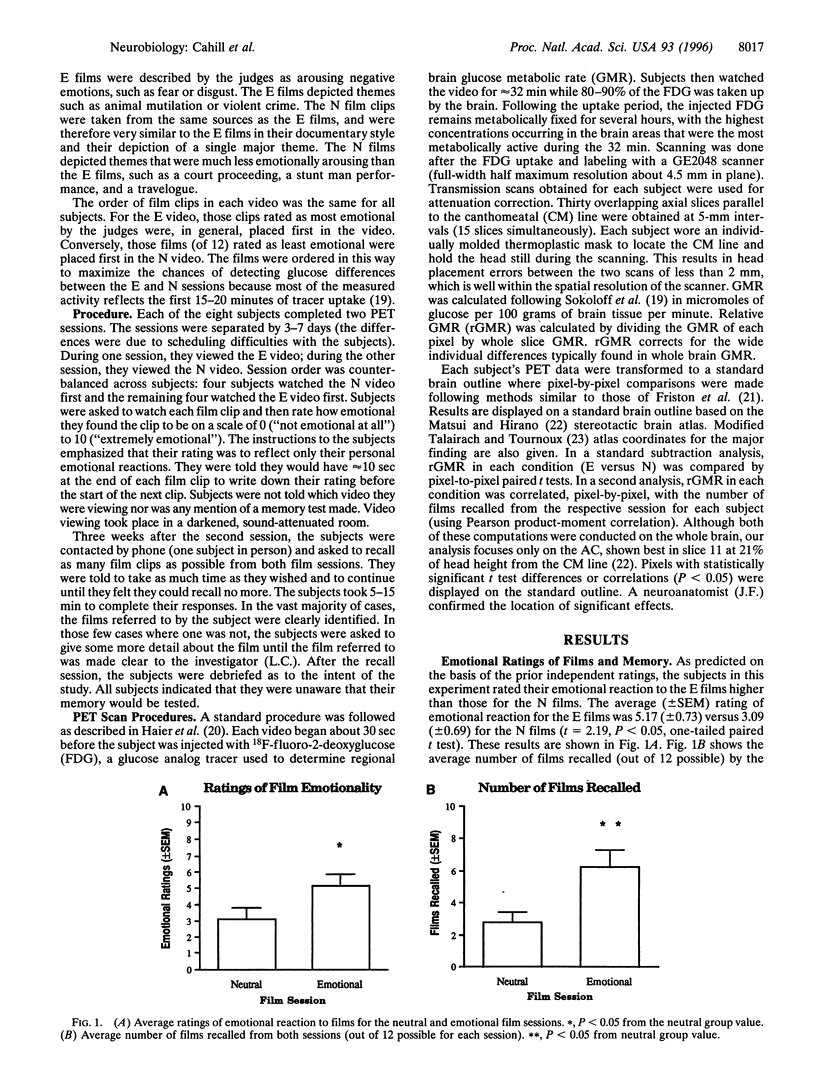
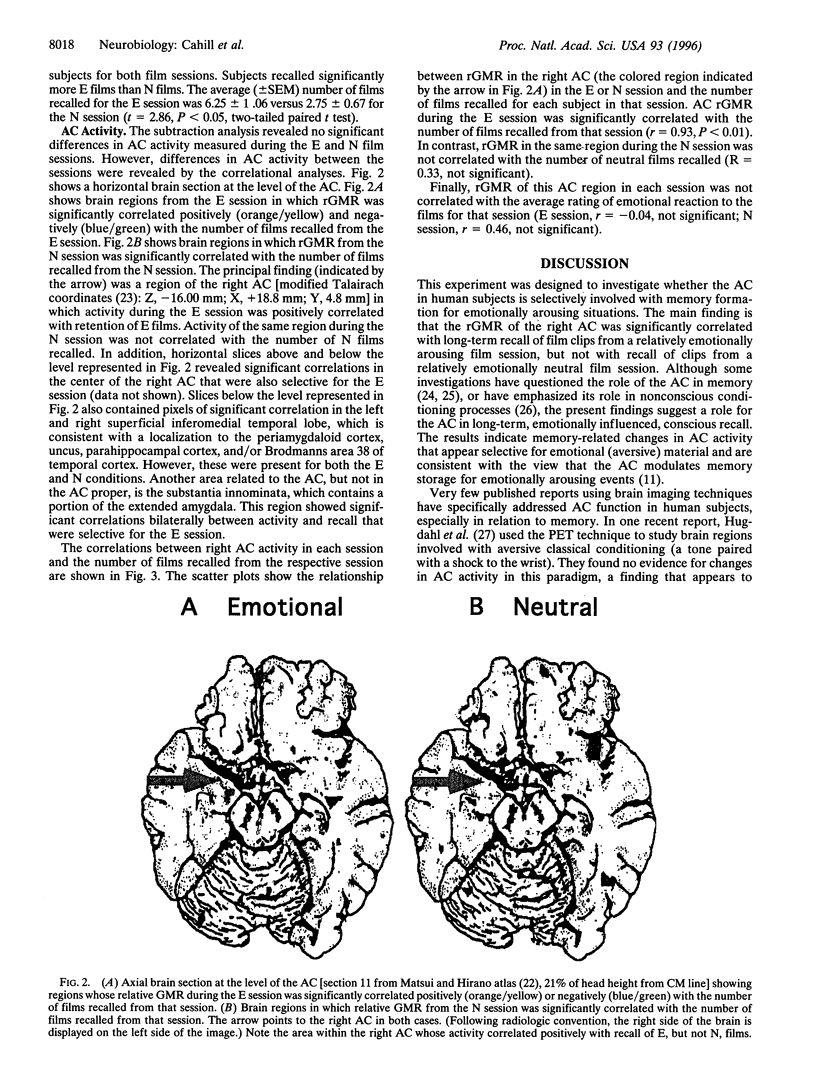
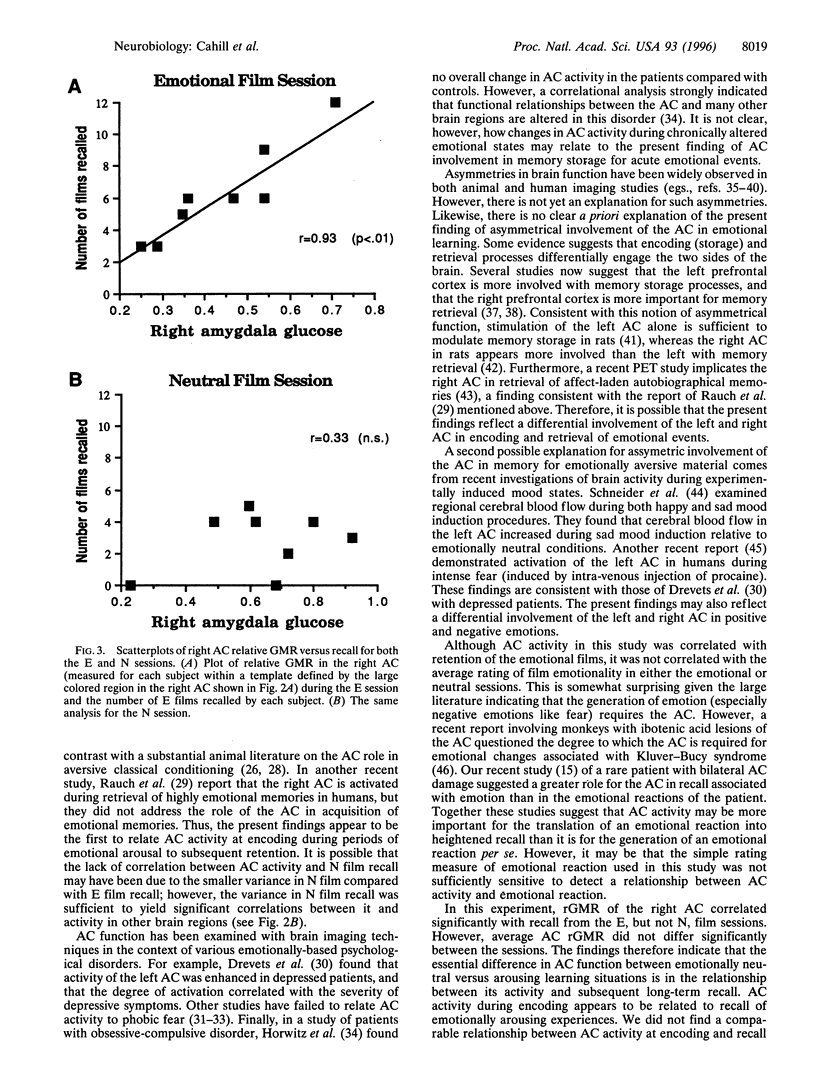
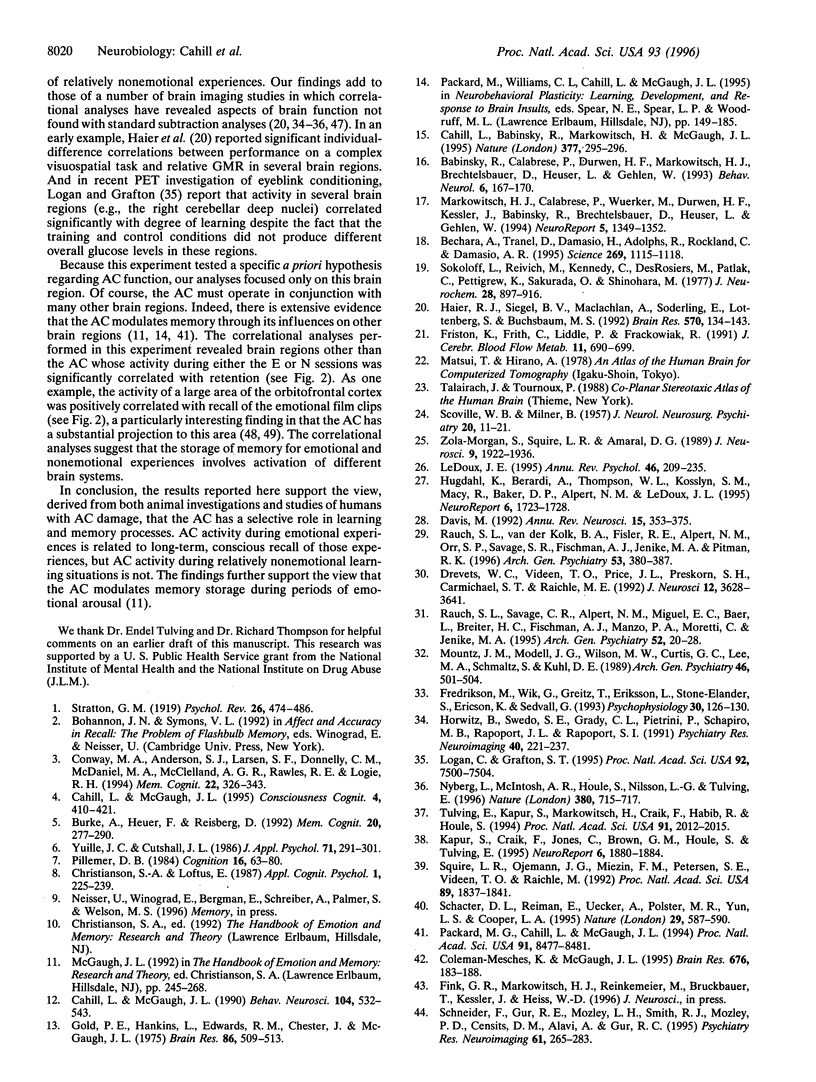
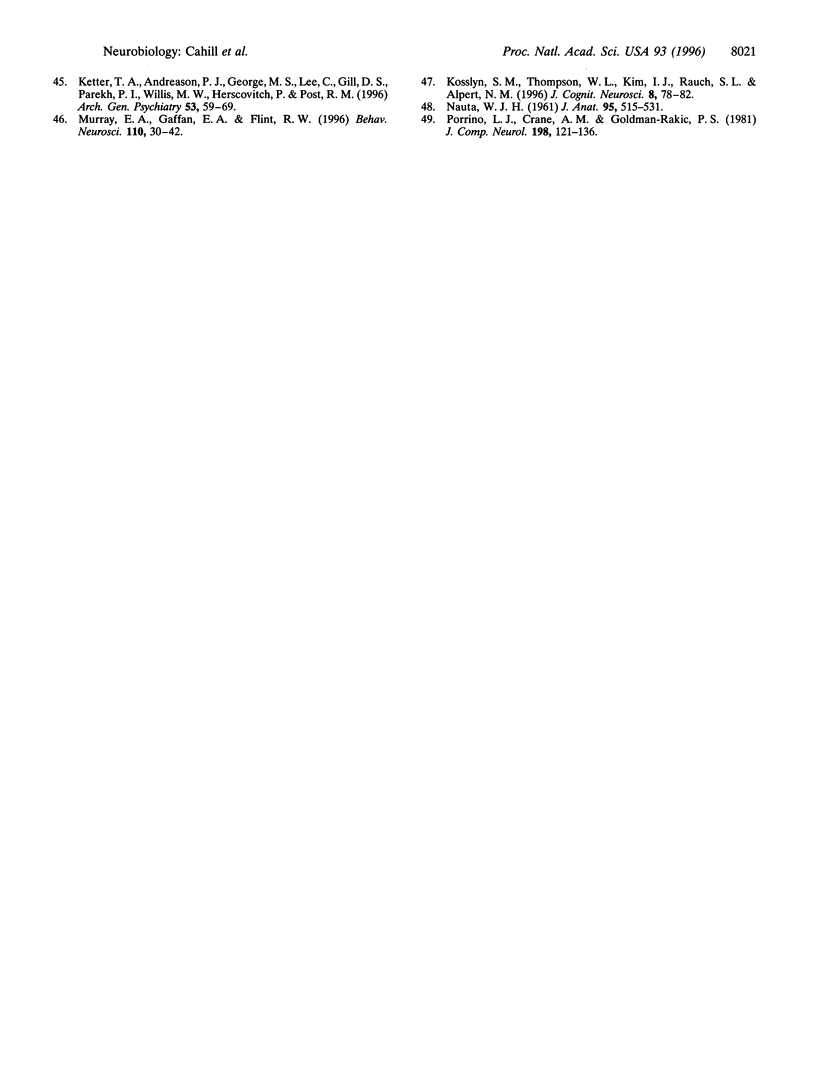
Images in this article
Selected References
These references are in PubMed. This may not be the complete list of references from this article.
- Bechara A., Tranel D., Damasio H., Adolphs R., Rockland C., Damasio A. R. Double dissociation of conditioning and declarative knowledge relative to the amygdala and hippocampus in humans. Science. 1995 Aug 25;269(5227):1115–1118. doi: 10.1126/science.7652558. [DOI] [PubMed] [Google Scholar]
- Burke A., Heuer F., Reisberg D. Remembering emotional events. Mem Cognit. 1992 May;20(3):277–290. doi: 10.3758/bf03199665. [DOI] [PubMed] [Google Scholar]
- Cahill L., Babinsky R., Markowitsch H. J., McGaugh J. L. The amygdala and emotional memory. Nature. 1995 Sep 28;377(6547):295–296. doi: 10.1038/377295a0. [DOI] [PubMed] [Google Scholar]
- Cahill L., McGaugh J. L. A novel demonstration of enhanced memory associated with emotional arousal. Conscious Cogn. 1995 Dec;4(4):410–421. doi: 10.1006/ccog.1995.1048. [DOI] [PubMed] [Google Scholar]
- Cahill L., McGaugh J. L. Amygdaloid complex lesions differentially affect retention of tasks using appetitive and aversive reinforcement. Behav Neurosci. 1990 Aug;104(4):532–543. doi: 10.1037//0735-7044.104.4.532. [DOI] [PubMed] [Google Scholar]
- Coleman-Mesches K., McGaugh J. L. Muscimol injected into the right or left amygdaloid complex differentially affects retention performance following aversively motivated training. Brain Res. 1995 Apr 3;676(1):183–188. doi: 10.1016/0006-8993(95)00108-3. [DOI] [PubMed] [Google Scholar]
- Conway M. A., Anderson S. J., Larsen S. F., Donnelly C. M., McDaniel M. A., McClelland A. G., Rawles R. E., Logie R. H. The formation of flashbulb memories. Mem Cognit. 1994 May;22(3):326–343. doi: 10.3758/bf03200860. [DOI] [PubMed] [Google Scholar]
- Davis M. The role of the amygdala in fear and anxiety. Annu Rev Neurosci. 1992;15:353–375. doi: 10.1146/annurev.ne.15.030192.002033. [DOI] [PubMed] [Google Scholar]
- Drevets W. C., Videen T. O., Price J. L., Preskorn S. H., Carmichael S. T., Raichle M. E. A functional anatomical study of unipolar depression. J Neurosci. 1992 Sep;12(9):3628–3641. doi: 10.1523/JNEUROSCI.12-09-03628.1992. [DOI] [PMC free article] [PubMed] [Google Scholar]
- Fredrikson M., Wik G., Greitz T., Eriksson L., Stone-Elander S., Ericson K., Sedvall G. Regional cerebral blood flow during experimental phobic fear. Psychophysiology. 1993 Jan;30(1):126–130. doi: 10.1111/j.1469-8986.1993.tb03211.x. [DOI] [PubMed] [Google Scholar]
- Friston K. J., Frith C. D., Liddle P. F., Frackowiak R. S. Comparing functional (PET) images: the assessment of significant change. J Cereb Blood Flow Metab. 1991 Jul;11(4):690–699. doi: 10.1038/jcbfm.1991.122. [DOI] [PubMed] [Google Scholar]
- Gold P. E., Hankins L., Edwards R. M., Chester J., McGaugh J. L. Memory interference and facilitation with posttrial amygdala stimulation: effect on memory varies with footshock level. Brain Res. 1975 Mar 28;86(3):509–513. doi: 10.1016/0006-8993(75)90905-1. [DOI] [PubMed] [Google Scholar]
- Haier R. J., Siegel B. V., Jr, MacLachlan A., Soderling E., Lottenberg S., Buchsbaum M. S. Regional glucose metabolic changes after learning a complex visuospatial/motor task: a positron emission tomographic study. Brain Res. 1992 Jan 20;570(1-2):134–143. doi: 10.1016/0006-8993(92)90573-r. [DOI] [PubMed] [Google Scholar]
- Horwitz B., Swedo S. E., Grady C. L., Pietrini P., Schapiro M. B., Rapoport J. L., Rapoport S. I. Cerebral metabolic pattern in obsessive-compulsive disorder: altered intercorrelations between regional rates of glucose utilization. Psychiatry Res. 1991 Dec;40(4):221–237. doi: 10.1016/0925-4927(91)90014-h. [DOI] [PubMed] [Google Scholar]
- Hugdahl K., Berardi A., Thompson W. L., Kosslyn S. M., Macy R., Baker D. P., Alpert N. M., LeDoux J. E. Brain mechanisms in human classical conditioning: a PET blood flow study. Neuroreport. 1995 Sep 11;6(13):1723–1728. doi: 10.1097/00001756-199509000-00005. [DOI] [PubMed] [Google Scholar]
- Kapur S., Craik F. I., Jones C., Brown G. M., Houle S., Tulving E. Functional role of the prefrontal cortex in retrieval of memories: a PET study. Neuroreport. 1995 Oct 2;6(14):1880–1884. doi: 10.1097/00001756-199510020-00014. [DOI] [PubMed] [Google Scholar]
- Ketter T. A., Andreason P. J., George M. S., Lee C., Gill D. S., Parekh P. I., Willis M. W., Herscovitch P., Post R. M. Anterior paralimbic mediation of procaine-induced emotional and psychosensory experiences. Arch Gen Psychiatry. 1996 Jan;53(1):59–69. doi: 10.1001/archpsyc.1996.01830010061009. [DOI] [PubMed] [Google Scholar]
- LeDoux J. E. Emotion: clues from the brain. Annu Rev Psychol. 1995;46:209–235. doi: 10.1146/annurev.ps.46.020195.001233. [DOI] [PubMed] [Google Scholar]
- Logan C. G., Grafton S. T. Functional anatomy of human eyeblink conditioning determined with regional cerebral glucose metabolism and positron-emission tomography. Proc Natl Acad Sci U S A. 1995 Aug 1;92(16):7500–7504. doi: 10.1073/pnas.92.16.7500. [DOI] [PMC free article] [PubMed] [Google Scholar]
- Markowitsch H. J., Calabrese P., Würker M., Durwen H. F., Kessler J., Babinsky R., Brechtelsbauer D., Heuser L., Gehlen W. The amygdala's contribution to memory--a study on two patients with Urbach-Wiethe disease. Neuroreport. 1994 Jun 27;5(11):1349–1352. [PubMed] [Google Scholar]
- Mountz J. M., Modell J. G., Wilson M. W., Curtis G. C., Lee M. A., Schmaltz S., Kuhl D. E. Positron emission tomographic evaluation of cerebral blood flow during state anxiety in simple phobia. Arch Gen Psychiatry. 1989 Jun;46(6):501–504. doi: 10.1001/archpsyc.1989.01810060021004. [DOI] [PubMed] [Google Scholar]
- Murray E. A., Gaffan E. A., Flint R. W., Jr Anterior rhinal cortex and amygdala: dissociation of their contributions to memory and food preference in rhesus monkeys. Behav Neurosci. 1996 Feb;110(1):30–42. [PubMed] [Google Scholar]
- NAUTA W. J. Fibre degeneration following lesions of the amygdaloid complex in the monkey. J Anat. 1961 Oct;95:515–531. [PMC free article] [PubMed] [Google Scholar]
- Nyberg L., McIntosh A. R., Houle S., Nilsson L. G., Tulving E. Activation of medial temporal structures during episodic memory retrieval. Nature. 1996 Apr 25;380(6576):715–717. doi: 10.1038/380715a0. [DOI] [PubMed] [Google Scholar]
- Packard M. G., Cahill L., McGaugh J. L. Amygdala modulation of hippocampal-dependent and caudate nucleus-dependent memory processes. Proc Natl Acad Sci U S A. 1994 Aug 30;91(18):8477–8481. doi: 10.1073/pnas.91.18.8477. [DOI] [PMC free article] [PubMed] [Google Scholar]
- Pillemer D. B. Flashbulb memories of the assassination attempt on President Reagan. Cognition. 1984 Feb;16(1):63–80. doi: 10.1016/0010-0277(84)90036-2. [DOI] [PubMed] [Google Scholar]
- Porrino L. J., Crane A. M., Goldman-Rakic P. S. Direct and indirect pathways from the amygdala to the frontal lobe in rhesus monkeys. J Comp Neurol. 1981 May 1;198(1):121–136. doi: 10.1002/cne.901980111. [DOI] [PubMed] [Google Scholar]
- Rauch S. L., Savage C. R., Alpert N. M., Miguel E. C., Baer L., Breiter H. C., Fischman A. J., Manzo P. A., Moretti C., Jenike M. A. A positron emission tomographic study of simple phobic symptom provocation. Arch Gen Psychiatry. 1995 Jan;52(1):20–28. doi: 10.1001/archpsyc.1995.03950130020003. [DOI] [PubMed] [Google Scholar]
- Rauch S. L., van der Kolk B. A., Fisler R. E., Alpert N. M., Orr S. P., Savage C. R., Fischman A. J., Jenike M. A., Pitman R. K. A symptom provocation study of posttraumatic stress disorder using positron emission tomography and script-driven imagery. Arch Gen Psychiatry. 1996 May;53(5):380–387. doi: 10.1001/archpsyc.1996.01830050014003. [DOI] [PubMed] [Google Scholar]
- SCOVILLE W. B., MILNER B. Loss of recent memory after bilateral hippocampal lesions. J Neurol Neurosurg Psychiatry. 1957 Feb;20(1):11–21. doi: 10.1136/jnnp.20.1.11. [DOI] [PMC free article] [PubMed] [Google Scholar]
- Schacter D. L., Reiman E., Uecker A., Polster M. R., Yun L. S., Cooper L. A. Brain regions associated with retrieval of structurally coherent visual information. Nature. 1995 Aug 17;376(6541):587–590. doi: 10.1038/376587a0. [DOI] [PubMed] [Google Scholar]
- Schneider F., Gur R. E., Mozley L. H., Smith R. J., Mozley P. D., Censits D. M., Alavi A., Gur R. C. Mood effects on limbic blood flow correlate with emotional self-rating: a PET study with oxygen-15 labeled water. Psychiatry Res. 1995 Nov 10;61(4):265–283. doi: 10.1016/0925-4927(95)02678-q. [DOI] [PubMed] [Google Scholar]
- Sokoloff L., Reivich M., Kennedy C., Des Rosiers M. H., Patlak C. S., Pettigrew K. D., Sakurada O., Shinohara M. The [14C]deoxyglucose method for the measurement of local cerebral glucose utilization: theory, procedure, and normal values in the conscious and anesthetized albino rat. J Neurochem. 1977 May;28(5):897–916. doi: 10.1111/j.1471-4159.1977.tb10649.x. [DOI] [PubMed] [Google Scholar]
- Squire L. R., Ojemann J. G., Miezin F. M., Petersen S. E., Videen T. O., Raichle M. E. Activation of the hippocampus in normal humans: a functional anatomical study of memory. Proc Natl Acad Sci U S A. 1992 Mar 1;89(5):1837–1841. doi: 10.1073/pnas.89.5.1837. [DOI] [PMC free article] [PubMed] [Google Scholar]
- Tulving E., Kapur S., Markowitsch H. J., Craik F. I., Habib R., Houle S. Neuroanatomical correlates of retrieval in episodic memory: auditory sentence recognition. Proc Natl Acad Sci U S A. 1994 Mar 15;91(6):2012–2015. doi: 10.1073/pnas.91.6.2012. [DOI] [PMC free article] [PubMed] [Google Scholar]
- Yuille J. C., Cutshall J. L. A case study of eyewitness memory of a crime. J Appl Psychol. 1986 May;71(2):291–301. [PubMed] [Google Scholar]
- Zola-Morgan S., Squire L. R., Amaral D. G. Lesions of the amygdala that spare adjacent cortical regions do not impair memory or exacerbate the impairment following lesions of the hippocampal formation. J Neurosci. 1989 Jun;9(6):1922–1936. doi: 10.1523/JNEUROSCI.09-06-01922.1989. [DOI] [PMC free article] [PubMed] [Google Scholar]



